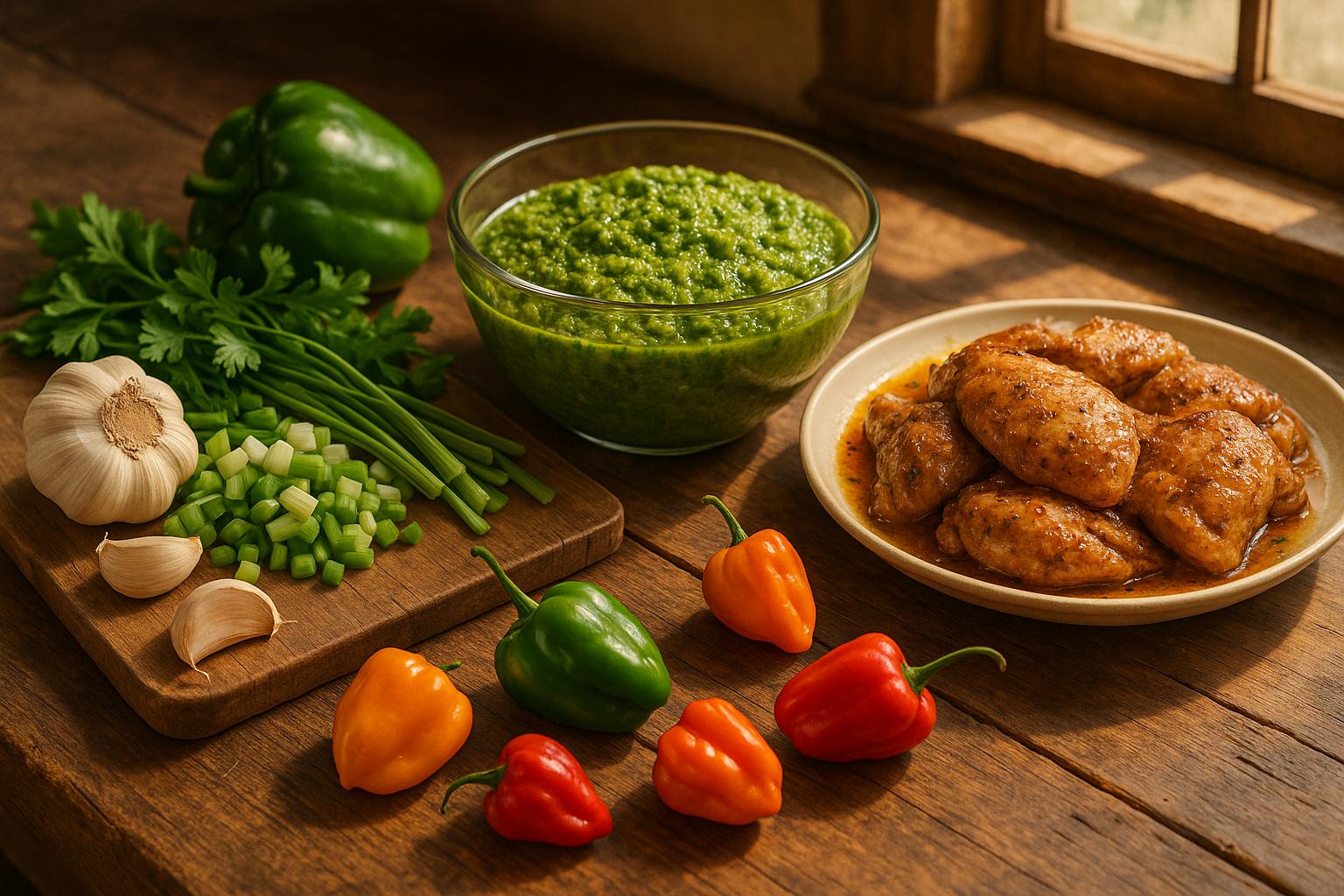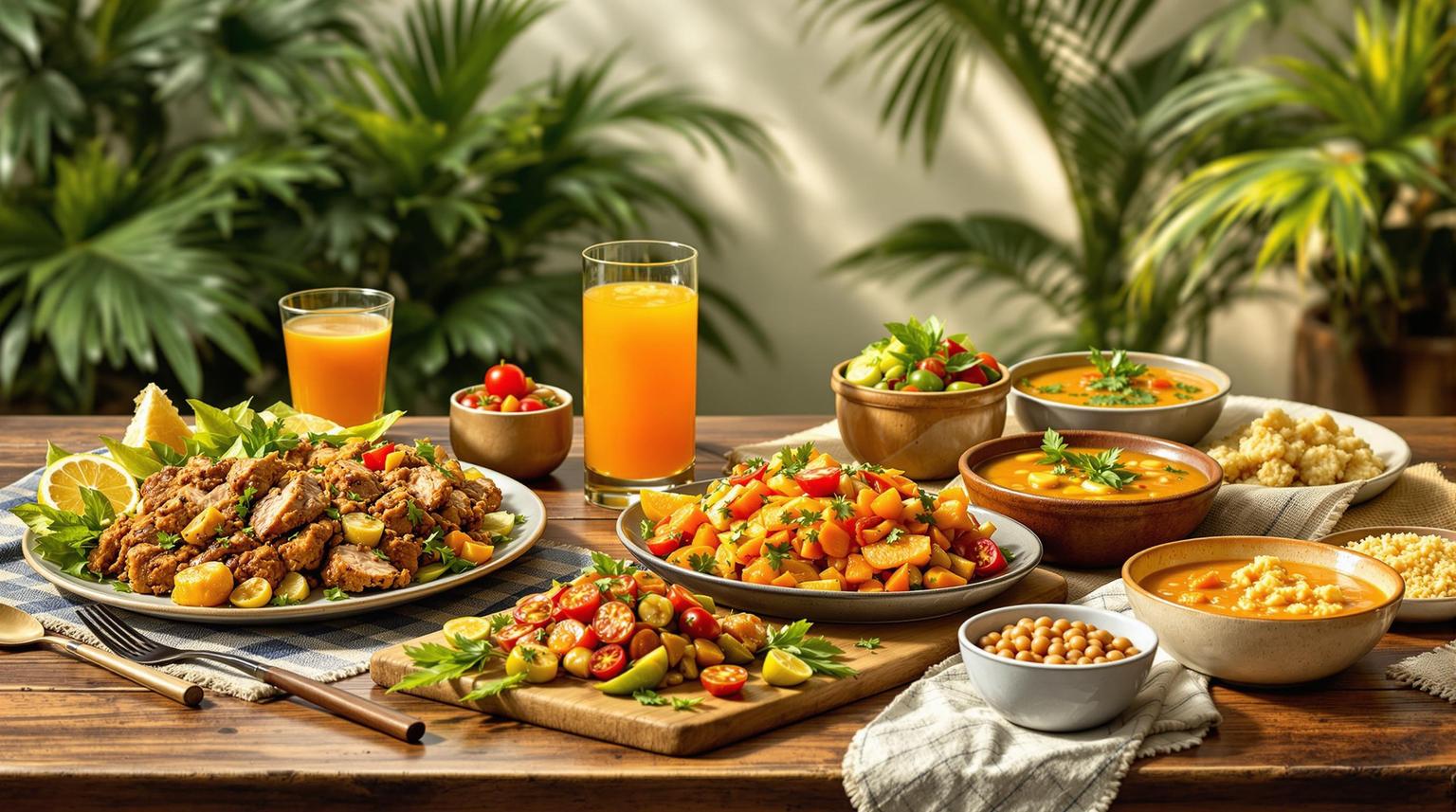Mortar and pestle or blender? When it comes to Haitian cooking, these tools serve different purposes but both are key for preparing dishes like épis - the seasoning base for many recipes. The mortar and pestle (pilon) connects you to centuries-old methods, offering better control over texture and flavor by crushing ingredients. Meanwhile, the blender is faster, easier for large batches, and ideal for busy kitchens.
Key Takeaways:
- Mortar and Pestle: Best for small batches, precise texture, and rich flavors. It requires some skill and effort but avoids overheating ingredients.
- Blender: Great for speed and handling large quantities, but it may over-process and slightly alter textures and flavors.
Quick Comparison:
| Feature | Mortar and Pestle | Blender |
|---|---|---|
| Flavor Development | Better, crushes ingredients | Good, but less effective |
| Texture Control | High, manual precision | Limited, may over-process |
| Time and Effort | Slower, more effort | Faster, less physical work |
| Batch Size | Small to medium | Large |
| Heat Impact | None | Motor can warm ingredients |
Whether you're honoring traditional cooking or need convenience, both tools have their place in Haitian kitchens.
Mortar and Pestle: The Old Method
History and Heritage
The pilon - Haiti's traditional mortar and pestle - carries a rich history that spans thousands of years. Tools for grinding, similar to the pilon, have been in use for over 40,000 years, with records of their presence in Ancient Egypt as early as 1550 BC [7][8]. In Haiti, the pilon is more than just a kitchen tool; it’s a cultural symbol. As Jonathan H. LaMare puts it:
"Pilons proudly represent traditional Haitian culture." [2]
The rhythmic pounding of the pilon is a familiar sound in Haitian households, especially in the mornings:
"When you hear me working, you know that someone in the household is preparing a meal." [2]
This tool plays a central role in making épis - a foundational ingredient in Haitian cuisine. For cookbook author Yveka Pierre, the pilon is deeply personal:
"Epis and my mother's pilon - and eventually my pilon - became both my root and my wings." [6]
This deep cultural connection sets the stage for understanding why the pilon remains irreplaceable in Haitian kitchens.
Flavor and Texture Benefits
The pilon isn’t just about tradition - it’s about taste. Its pounding action releases flavors in ways modern appliances simply can’t replicate. Unlike electric tools that slice, the pilon crushes herbs and spices, fully unlocking their essential oils and aromas [3]. As one expert explains:
"The pounding action of the pilon helps release the essential oils and aromas of the ingredients, giving Haitian dishes their distinctive and robust flavors." [3]
This method also keeps heat at bay, avoiding the bruising or over-processing that can occur with electric machines. It provides cooks with control over texture, whether they’re aiming for a coarse grind or a smooth paste [10]. This hands-on process fosters a deeper connection between the cook and the ingredients.
Haitian chef Judith Laguerre highlights its importance:
"We use knives to chop rather than a food processor. And we love our mortar and pestle - which we call a 'balon' - because it brings out a spice's true flavor." [9]
Beyond épis, the pilon is versatile. It grinds corn into cornmeal for mais moulin and crushes herbs for medicinal teas, showcasing its role in a wide range of Haitian dishes [2].
Drawbacks and Tips
While the pilon offers unmatched flavor, it does come with a learning curve. Using it is physically demanding and requires practice [4]. One expert notes:
"Crushing garlic cloves, whole peppercorn or rock salt with this tool is the work of the experts. You have to know just the right rhythm for them not to jump out of the pestle while you attempt to crush them with the mortar." [4]
Mastering the rhythm is essential to keep ingredients from escaping during use [4].
Choosing the right material for your pilon is equally important. Wooden pilons are lightweight and easier to handle, making them great for everyday tasks. On the other hand, stone pilons offer a more thorough grind, ideal for tougher ingredients [11]. To get the best results, always use fresh herbs and spices; dried or stale ones won’t release the oils that make this method so effective [11].
Proper care is crucial for maintaining a pilon. Avoid using soap, as it can strip away the seasoning built over time. Instead, simply rinse or wipe it clean:
"Simply wipe me down or rinse me. That way, I can hold on to the flavors of all the meals that began in me." [2]
This approach helps preserve the flavors and history embedded in the tool [2].
Despite its challenges, the pilon remains an essential tool for authentic Haitian cooking. The effort it demands is more than repaid in the enhanced flavors and the deep sense of connection it brings to the culinary experience [4].
Epis with Mortar & Pestle (Pilon)#haitianrecipes #haitian
Blender: The Modern Option
While the mortar and pestle evoke a sense of tradition and craftsmanship, blenders cater to the fast-paced demands of modern life with their efficiency and convenience.
Speed and Ease
Blenders streamline the preparation of traditional Haitian recipes, cutting down on time and effort. For busy families looking to preserve their culinary heritage without spending hours in the kitchen, this can be a game-changer.
Beyond speed, blenders are practical for handling larger quantities of ingredients, making them ideal for meal prepping or cooking for bigger households. Cleanup is simple too - often, a quick rinse or a soap wash is all it takes[5][14]. However, using a blender to recreate traditional dishes requires a bit of finesse to ensure the flavors and textures stay true to the original recipes.
Using Blenders for Old Recipes
With some care, blenders can replicate traditional recipes like épis. The key is to control the process. Gradually adding ingredients and using the pulse setting can help achieve a texture that's closer to the rustic, pesto-like consistency of épis. Charla from That Girl Cooks Healthy suggests:
"Use a food processor if possible not a blender to reserve some of the texture. Epis shouldn't be too much of a liquid texture. If you do use a blender control the texture by adding the ingredients in stages to ensure it's not over pureed." [13]
Another important tip is to avoid adding extra water. The natural moisture from the ingredients is usually enough to achieve the desired consistency[1].
Blender Limitations
Despite their advantages, blenders have their downsides. One issue is heat. The motor can warm up during blending, which may affect the delicate flavors of fresh herbs like lemongrass, an essential ingredient in many Haitian dishes[5][14].
Texture control can also be tricky. Marwin Brown from Food Fidelity explains:
"Most use a blender or food processor, but I actually prefer a mortar and pestle to control the texture." [12]
Blenders often over-process ingredients, turning épis into a smooth, liquid-like consistency instead of the coarse, rustic paste that traditional methods produce. The blending action, which cuts and ruptures ingredients, doesn’t release flavors as effectively as the crushing and grinding of a pilon. Marion's Kitchen highlights this difference:
"Curry pastes taste better made by pounding as it better releases and melds all the aromas and flavour compounds." [5]
Another challenge arises when making pastes for frying. Blenders often require added liquid to function properly, which can lead to a wetter paste. When this hits hot oil, it tends to stew rather than fry, altering the dish’s flavor profile[5]. On the other hand, pastes made with a pilon typically retain just the right amount of natural moisture, making them perfect for frying.
sbb-itb-80c33ff
Mortar vs. Blender: Side-by-Side Comparison
Let’s break down how these tools stack up for Haitian cooking.
Comparison Table: Mortar and Pestle vs. Blender
| Factor | Mortar and Pestle | Blender |
|---|---|---|
| Texture Control | Excellent – lets you create a smooth or slightly chunky consistency | Over-processes ingredients into a uniform paste |
| Flavor Development | Superior – pounding releases and blends aromas naturally | Good – cutting is efficient but may not extract as much |
| Time Required | Takes longer with more manual effort | Quick and efficient, perfect for tight schedules |
| Batch Size | Best for small to medium batches | Handles large batches with ease |
| Heat Generation | No heat generated, keeping ingredients cool | Motor speed can create heat, affecting delicate herbs |
| Liquid Requirements | Uses natural moisture from ingredients | Often needs added liquid, which can slightly alter results |
| Cleanup | Requires moderate scrubbing | Easier to clean - just rinse or wash |
| Authenticity | A traditional method rich in heritage | A modern, convenient alternative |
As Marion's Kitchen puts it:
"Pastes made in a mortar and pestle are smoother, and you can more easily check the texture as you go." [5]
This breakdown highlights the strengths of each tool, helping you decide which fits your cooking needs.
How to Choose the Right Tool
The mortar and pestle is perfect for precise textures and honoring tradition, while the blender excels in speed and handling larger quantities.
When to use a mortar and pestle:
- Crafting traditional épis for dishes like Poul Nan Sos, Griyo, or Sos Pwa Nwa
- Prioritizing control over texture and flavor
- Working with smaller batches where manual techniques shine
- Enjoying the hands-on process tied to Haitian heritage
When to use a blender:
- Cooking for a crowd or meal prepping quickly
- Working under tight time constraints
- Needing smooth, consistent results for marinades or sauces
Many Haitian cooks swear by keeping both tools at the ready. This way, you can savor the authenticity of traditional methods when you have time and lean on the blender for modern convenience when life gets busy.
Conclusion: Old Methods and New Tools
In Haitian cooking, both the mortar and pestle and the modern blender have their place. The mortar brings out rich, deep flavors and aromas, while the blender offers speed and convenience.
Each tool has its strengths. When you're aiming for that traditional, home-cooked flavor and have the time to dedicate, the mortar and pestle is your go-to. On the other hand, if you're short on time or cooking for a large group, the blender steps in as a practical solution. It’s not about picking one tool over the other - it’s about understanding how both can enhance your cooking experience. Many seasoned cooks rely on both, choosing based on the dish, the occasion, or simply how much time they have.
Whether you're making classic épis or whipping up quick marinades, both tools help create the bold, vibrant flavors Haitian cuisine is known for. The key is to keep experimenting, cooking, and sharing these wonderful dishes with those around you.
Learn More with HaitianFoods.org

Dive deeper into the art of Haitian cooking with HaitianFoods.org. The platform offers detailed recipes, insights into traditional cooking techniques, and a broader understanding of Haitian culinary traditions. You can also explore a directory of authentic Haitian restaurants worldwide, giving you a chance to taste these methods in action and gather inspiration for your own kitchen. Whether you're embracing old methods or modern tools, HaitianFoods.org is your guide to mastering the flavors of Haiti.
FAQs
What makes a mortar and pestle better than a blender for Haitian recipes?
Using a mortar and pestle in Haitian cooking offers benefits that a blender just can't match. It gives you precise control over texture, helping achieve a smoother and more uniform consistency. Plus, the gentle crushing action releases the natural moisture and essential oils in ingredients, which deepens the flavors and makes them more vibrant.
This technique is especially crucial for preparing traditional Haitian staples like epis - the aromatic seasoning base - or spice blends. These dishes rely on preserving the full aroma and flavor of the ingredients. While a blender might save time, the mortar and pestle deliver a richer taste that truly embodies the heart of Haitian cuisine.
Can I use a blender to make Haitian épis instead of a mortar and pestle?
Can You Use a Blender to Make Haitian Épis?
Absolutely! You can whip up Haitian épis using a blender without losing its signature flavor and texture. Start by combining fresh ingredients like garlic, scallions, bell peppers, thyme, and parsley in the blender. To keep the texture traditional, blend in small batches and aim for a slightly chunky consistency - this mimics the results you'd get from a mortar and pestle.
For an extra punch of flavor, add a splash of lime juice or vinegar. This approach offers a quick and easy way to recreate the vibrant, aromatic essence of Haitian épis, making it perfect for seasoning all your favorite dishes.
How do I properly care for a traditional Haitian pilon?
To maintain your traditional Haitian pilon, start by cleaning it with water and a soft brush - skip the soap, as it might harm the material. Once it's clean, make sure to dry it completely and apply a thin layer of food-safe oil to keep the surface in top shape. Store your pilon in a dry spot, and check it regularly to ensure there's no moisture buildup, which could lead to cracking or mold. Stick to gentle cleaning methods to protect the wood or stone and keep it lasting for years.


